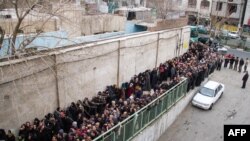New statistics released by the World Bank reveal that Iran has had a painful economic decline during the past four decades of the Islamic Republic's clerical rule.
It appears that those who take pride in Iran’s widespread military presence in the region, deliberately or unknowingly ignore the collapse of the country’s national economy.
New statistics released by the World Bank estimate Iran’s total Gross Domestic Product (GDP) during the past year at 439 billion dollars.
GDP, simply put, is the total value of all the goods and services produced in a country within a year. Divided by the total population of a country, we arrive at per capita GDP.
Figures released by the World Bank reveal that the Iranian economy has dropped from the 17th t0 27th place in the world during the past four decades.
During the same period, Turkey has ascended from the 27th place to the 17th.
At the same time, Turkey’s GDP which was half the figure for Iran in the early 1980s, has nearly doubled during the past forty years.
As Iran’s and Turkey’s populations are at the same level, the figures show that every citizen of Turkey has produced twice as much wealth as his or her Iranian counterpart.
The gap between the two countries’ economies becomes more meaningful when we consider that unlike Turkey, Iran is rich in natural resources. Iran is a major oil producer while Turkey spends a lot on importing oil and gas from other countries.
Meanwhile, comparing Iran to Saudi Arabi in terms of GDP reveals Iran’s economic decline even more clearly.
According to the World Bank, the 2017 GDP of Saudi Arabia, a country with 32 million population is 683 billion dollars, that is 244 billion dollars more than Iran, a country with a population of 81 million.
This comes while Iran’s fossil fuel reserves of oil and gas are higher than those of the Kingdom of Saudi Arabia.
The most tangible consequence of this economic decline is a drop in living standards for Iranians.
The World Bank estimate of the average per capita GDP in Iran based on the Iranian currency’s real purchasing power between 1976 and 2017 reveal that during this period, an average Iranian has become 32 percent poorer.
The World Bank estimate is more or less consistent with figures Iranian economists have come up with. Dr. Massoud Nili, an economic adviser to Iran’s President Hassan Rouhani, says the current per capita income in Iran is 70% of the per capita income in 1976. In other words, he confirms that Iranians have become 30% poorer during the past four decades.
This might even be a conservative estimate, as the World Bank and other international organizations sometimes rely on more rosy figures published by the government of the target country to gauge real inflation or unemployment.
There are many reasons for Iran’s economic decline over the past forty years including war, economic sanctions, corruption, brain drain and capital migration. Ignorance of the leadership, however, is the root cause of many problems.
Within half a century before the 1979 Islamic revolution, which brought clerics to power, particularly during the “golden 15 years” from the early 1960s to mid-1970s, Iran had a dynamic economy, although it was facing many problems such as the shock which was the legacy of World War II, political havoc, corruption and so on. During that period, men and women who believed in modernity and understood the modern world, worked hard in order to make Iran progressive and developed.
The Islamic revolution put an end to economic development and progress and handed over the country’s management to those who opposed modernity and did not know the modern world around them.
Iran’s economic decline is one of the most significant manifestations of that tragic situation.








